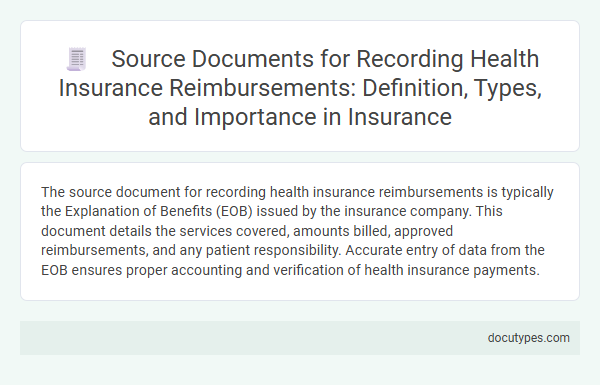The source document for recording health insurance reimbursements is typically the Explanation of Benefits (EOB) issued by the insurance company. This document details the services covered, amounts billed, approved reimbursements, and any patient responsibility. Accurate entry of data from the EOB ensures proper accounting and verification of health insurance payments.
Introduction to Source Documents in Health Insurance
Health insurance reimbursements rely on accurate documentation to ensure proper recording and processing. Source documents serve as the foundational records that validate claims and payments within health insurance systems.
Common source documents include Explanation of Benefits (EOB), medical bills, and payment receipts. You need these documents to track reimbursement details and maintain accurate financial records related to health insurance claims.
Definition of Source Documents for Insurance Reimbursements
Source documents for recording health insurance reimbursements are original records that provide evidence of transactions between policyholders, healthcare providers, and insurance companies. These documents include claim forms, Explanation of Benefits (EOB), and payment receipts, which validate the amount reimbursed.
Accurate source documents ensure proper accounting and verification of insurance reimbursements in health records. Your financial records depend on these documents to confirm reimbursement amounts and maintain compliance with regulatory standards.
Key Types of Source Documents in Health Insurance
The source document for recording health insurance reimbursements is essential for accurate financial tracking and claim processing. These documents provide detailed evidence of services rendered and payments made.
Key types of source documents in health insurance include Explanation of Benefits (EOB) statements, insurance claim forms, and medical bills. EOBs outline the amount covered by insurance and patient responsibilities. Insurance claim forms detail the services claimed, while medical bills verify the costs associated with the treatments.
Role of Claim Forms in Insurance Reimbursement
| Topic | Details |
|---|---|
| Source Document for Health Insurance Reimbursements | The primary source document for recording health insurance reimbursements is the claim form submitted to the insurance company after medical services are provided. |
| Role of Claim Forms | Claim forms serve as official requests for payment to the insurance provider. They detail the patient's medical services, diagnoses, and costs, allowing the insurer to process reimbursement accurately. |
| Importance in Insurance Reimbursement | These documents are essential for verifying the services offered and determining the amount to be reimbursed. Without properly completed claim forms, reimbursement delays or denials may occur. |
| Your Responsibility | You must ensure the claim forms are accurately filled out and submitted promptly to facilitate timely health insurance reimbursements. |
Importance of Medical Bills as Source Documents
The source document for recording health insurance reimbursements is primarily the medical bill. Medical bills provide detailed information on services rendered, including dates, procedures, and costs, which are crucial for accurate reimbursement processing. These documents serve as the official record ensuring claims are verified and payments are correctly allocated.
Supporting Documents: Prescriptions and Reports
What is the source document for recording health insurance reimbursements? The primary source documents include prescriptions and medical reports provided by healthcare professionals. These supporting documents validate the treatments and services eligible for reimbursement under health insurance policies.
Legal and Compliance Aspects of Source Documents
The source document for recording health insurance reimbursements is the Explanation of Benefits (EOB) provided by the insurer. Understanding the legal and compliance aspects of this document ensures accurate financial reporting and adherence to regulations.
- Explanation of Benefits (EOB) - This document details the insurer's payment decisions and patient responsibility, serving as the primary record for reimbursement entries.
- Compliance with HIPAA - EOBs must comply with HIPAA regulations to protect patient confidentiality and ensure secure handling of sensitive information.
- Audit and Legal Verification - EOBs provide legally recognized proof of reimbursement transactions, supporting audits and dispute resolution related to health insurance claims.
Importance of Accurate Source Documentation in Reimbursement
The source document for recording health insurance reimbursements is typically the Explanation of Benefits (EOB) issued by the insurance provider. Accurate source documentation ensures that reimbursements are recorded correctly, reflecting the exact amounts paid and services covered. Proper documentation helps prevent billing errors, supports compliance with insurer requirements, and facilitates efficient claims auditing.
Challenges in Managing Insurance Source Documents
Source documents for recording health insurance reimbursements typically include Explanation of Benefits (EOB) statements and insurance remittance advices. These documents serve as the primary records for verifying and processing reimbursement claims.
Challenges in managing insurance source documents often arise from inconsistent formats and delayed submissions, complicating accurate data entry. Ensuring document accuracy and completeness is critical for avoiding claim denials and payment errors.
- Document Variability - Insurance source documents come in various formats from different providers, making standardization difficult for electronic processing.
- Timeliness Issues - Delays in receiving Explanation of Benefits and remittance advices hinder prompt recording of reimbursements and impact cash flow management.
- Data Accuracy - Errors or omissions in source documents require extensive verification to prevent incorrect reimbursement entries and potential audit risks.
What Is the Source Document for Recording Health Insurance Reimbursements? Infographic

